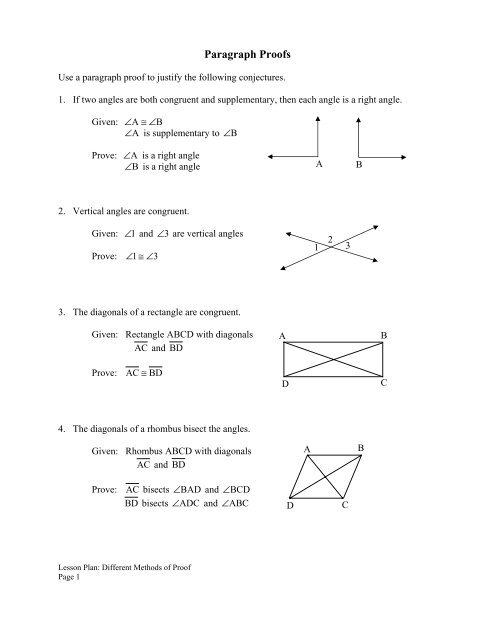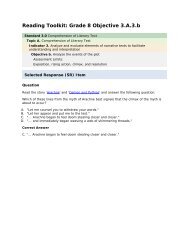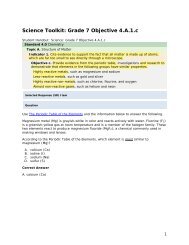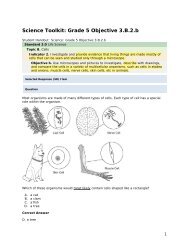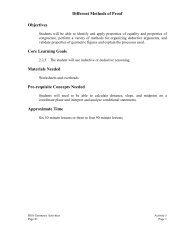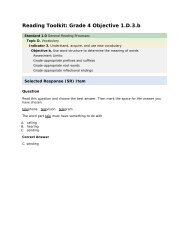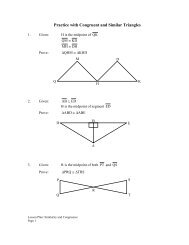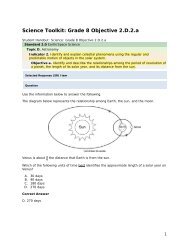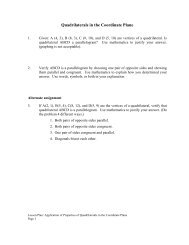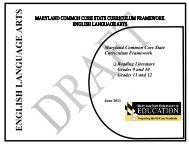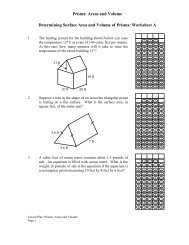Paragraph Proofs - mdk12
Paragraph Proofs - mdk12
Paragraph Proofs - mdk12
You also want an ePaper? Increase the reach of your titles
YUMPU automatically turns print PDFs into web optimized ePapers that Google loves.
<strong>Paragraph</strong> <strong>Proofs</strong><br />
Use a paragraph proof to justify the following conjectures.<br />
1. If two angles are both congruent and supplementary, then each angle is a right angle.<br />
Given: ∠A≅∠<br />
B<br />
∠ A is supplementary to ∠ B<br />
Prove:<br />
∠ A is a right angle<br />
∠ B is a right angle<br />
A<br />
B<br />
2. Vertical angles are congruent.<br />
Given: ∠ 1 and ∠ 3 are vertical angles<br />
Prove: ∠1≅∠<br />
3<br />
1<br />
2<br />
3<br />
3. The diagonals of a rectangle are congruent.<br />
Given: Rectangle ABCD with diagonals<br />
AC and BD<br />
Prove: AC ≅ BD<br />
A<br />
D<br />
B<br />
C<br />
4. The diagonals of a rhombus bisect the angles.<br />
Given: Rhombus ABCD with diagonals<br />
AC and BD<br />
A<br />
B<br />
Prove: AC bisects<br />
BD bisects<br />
∠ BAD and ∠ BCD<br />
∠ ADC and ∠ ABC<br />
D<br />
C<br />
Lesson Plan: Different Methods of Proof<br />
Page 1
<strong>Paragraph</strong> <strong>Proofs</strong> (Continued)<br />
5. Angles inscribed in a semicircle are right angles.<br />
Given:<br />
∠ B is inscribed in circle O<br />
B<br />
Prove:<br />
ABC is a semicircle<br />
∠ B is a right angle<br />
A<br />
.<br />
O<br />
.<br />
D<br />
C<br />
6. If a quadrilateral is inscribed in a circle, then the opposite angles are supplementary.<br />
Given: Quadrilateral ABCD is<br />
inscribed in circle O<br />
Prove:<br />
∠ A is supplementary to ∠ C<br />
∠ B is supplementary to ∠ D<br />
A<br />
B<br />
C<br />
.<br />
O<br />
.<br />
D<br />
B<br />
7. Parallel lines intercept congruent arcs on a circle.<br />
Given:<br />
AB<br />
CD<br />
A<br />
Prove: AC ≅ BD<br />
(Hint: Draw segment AD)<br />
C<br />
D<br />
Lesson Plan: Different Methods of Proof<br />
Page 2
Answers: 1. ∠A<br />
is congruent to ∠B<br />
and ∠ A is supplementary to ∠ B .<br />
Since the two angles are supplementary, their sum is 180º.<br />
Since they are congruent, they can be substituted for one<br />
another, meaning that ∠ A + ∠ B is equal to 180º, but also<br />
that 2 times ( ∠ B ) is equal to 180º. Then, ∠ B = 90º by the<br />
division property of equality. Since the two angles are<br />
congruent, ∠ A also = 90º. ∠ A and ∠B<br />
are right angles<br />
by the definition of right angles.<br />
2. ∠ 1 and ∠ 3 are vertical angles. Since they are vertical<br />
angles, there is an angle in between them, ∠ 2 , which is<br />
adjacent to both angles and supplementary to both angles.<br />
Since both ∠ 1 and ∠ 3 are supplementary to ∠ 2 , ∠ 1 +<br />
∠ 2 = 180º and ∠ 2 + ∠ 3 = 180º. ∠ 1 + ∠ 2 = ∠ 2 + ∠ 3<br />
by the application of the transitive property of equality. ∠ 1<br />
and ∠ 3 are congruent because to the subtraction property<br />
of equality.<br />
3. ABCD is a rectangle with AC and BD as diagonals. Since<br />
ABCD is a rectangle, opposite sides AB and CD are<br />
congruent. In addition, BC and DA are congruent. Since<br />
ABCD is a rectangle, ∠ B and ∠ C are right angles, and<br />
both equal to 90º by the definition of right angles. Since<br />
both are equal to 90º, they are equal to one another by the<br />
transitive property. Δ ABC and Δ BCD are congruent by<br />
the side-angle-side triangle congruence theorem. AC is<br />
congruent to BD by the definition of congruent triangles.<br />
4. ABDC is a rhombus with diagonals AC and BD . Since<br />
ABCD is a rhombus, all four sides are congruent. In<br />
addition, AC ≅ AC and BD ≅ BD by the reflexive<br />
property of congruence. Δ ABC is congruent to Δ CDA<br />
and Δ BCD is congruent to Δ DAB by the side-side-side<br />
triangle congruence theorem. Therefore,<br />
∠ BAC ≅ ∠DAC<br />
∠ BCA ≅ ∠DCA<br />
∠ ABD ≅ ∠CBD<br />
∠ CDA ≅ ∠ADC<br />
by the definition of triangle congruence. AC bisects<br />
∠ BAD and ∠ BCD and BD bisects ∠ ADC and ∠ ABC<br />
by the definition of angle bisectors.<br />
5. ∠ B is inscribed in circle O and ABC is a semicircle. The<br />
measure of arc ABC is 180º by the definition of a<br />
semicircle. The m ∠ B is 90º because the measure of an<br />
inscribed angle is half the measure of its intercepted arc.<br />
Therefore, by definition of a right angle, ∠ B is a right<br />
angle.<br />
Lesson Plan: Different Methods of Proof<br />
Page 3
6. Quadrilateral ABCD is inscribed in circle O. There are<br />
360º in a circle, so m ABC + m CDA = 360º and the<br />
m BCD + m DAB = 360º. By the division property of<br />
1 1<br />
equality, m ABC + m CDA = 180º and<br />
2 2<br />
1 1 m BCD + m DAB = 180º.<br />
2 2<br />
1 1<br />
The m ∠ D = m ABC, m ∠ B = m CDA,<br />
2 2<br />
1 1<br />
m∠ A = m BCD, and m ∠ C = m DAB because the<br />
2 2<br />
measure of an inscribed angle is one-half the measure of its<br />
intercepted arc. m ∠ D + m ∠ B = 180º and m ∠ A + m ∠ C<br />
= 180º by substitution. Therefore, ∠ A is supplementary to<br />
∠C<br />
and ∠ B is supplementary to ∠D<br />
by definition of<br />
supplementary angles.<br />
7. AB is parallel to CD . Draw AD . ∠ BAD ≅ ∠CDA<br />
because if two parallel lines are cut by a transversal, the<br />
alternate interior angles are congruent. ∠ BAD = ∠CDA<br />
1<br />
by the definition of congruent angles. m ∠ BAD = m BD 2<br />
1<br />
and m ∠ CDA = m AC because the measure of an<br />
2<br />
inscribed angle is one-half the measure of its intercepted<br />
arc. 2<br />
1 m BD = 2<br />
1 m AC by substitution. The measure of<br />
BD = m AC by the multiplication property of equality.<br />
Therefore, AC ≅ BD by the definition of congruent arcs.<br />
Lesson Plan: Different Methods of Proof<br />
Page 4


